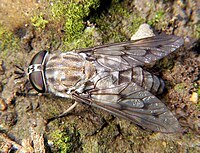
Photo from wikipedia
Objectives Good-quality and sufficient DNA is essential for diagnostics and vaccine development. We aimed to compare six DNA extraction techniques applied to Loa loa microfilariae in order to evaluate the… Click to show full abstract
Objectives Good-quality and sufficient DNA is essential for diagnostics and vaccine development. We aimed to compare six DNA extraction techniques applied to Loa loa microfilariae in order to evaluate the purity and integrity of extracts in terms of quality and quantity. Methods The microfilariae were purified via a Percoll gradient procedure with blood from hyper-microfilaremic individuals (> 30,000 microfilaria [mf]/ml). DNA extraction was carried out in duplicate at a rate of 350,000 mf/tube for each technique: phenol/chloroform, commercial Qiagen kit, salting out, Tris-EDTA, methanol, and cetyltrimethylammonium bromide (CTAB). The integrity, purity, concentration, and quality of the DNA extracts were successively verified by agarose gel electrophoresis, spectrophotometry (A260/A280 and A260/A230 wavelength ratio), Qubit fluorometry, and endonuclease and polymerase activity. The six techniques were compared on the basis of the following parameters: concentration, purity, efficiency, effectiveness, integrity, safety of the technique, as well as cost and duration of the protocol. Results The ratios of the optical densities of the extracts A260/A280 and A260/A230 were, respectively: phenol/chloroform (1.82; 1.11), Qiagen (1.93; 1.36), salting-out (1.9; 2.04), Tris-EDTA (1.99; 1.183), methanol (2.126; 1.343), and CTAB (2.01; 2.426). The DNA yield was: phenol/chloroform (3.920 μg), Qiagen (10.280 μg), salting-out (10.390 μg), Tris-EDTA (0.5528 μg), methanol (0.1036 μg), and CTAB (1.115 μg). Endonuclease and polymerase activity was demonstrated by digestion of DNA and through amplicons obtained via polymerase chain reaction assays with phenol/chloroform, Qiagen, and salting-out extracts. Conclusion The phenol/chloroform, Qiagen, and salting-out DNA extracts were all of good quality. Salting out had the best yield followed by Qiagen and then phenol/chloroform. Endonuclease and polymerase activity was effective in all three extracts despite the presence of some contaminants. These methods are therefore suitable for the extraction of DNA from Loa loa microfilariae. Tris-EDTA and methanol did not show adequate sensitivity, while CTAB was found to be unsuitable.
Journal Title: PLoS ONE
Year Published: 2022
Link to full text (if available)
Share on Social Media: Sign Up to like & get
recommendations!